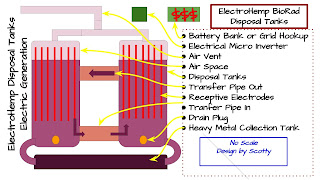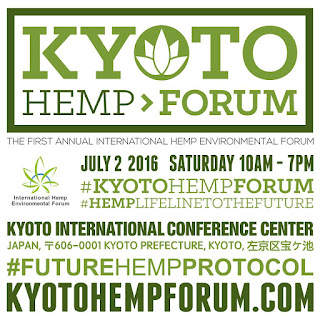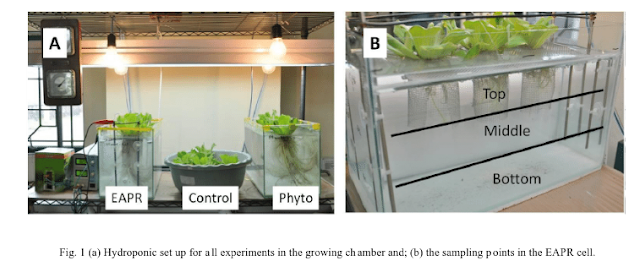Eye Opening Discussion on Phytoremediation- the stuff that was most appealing to me started at 31:00 and talks about phytoremediation of Heavy Metals and Nuclides: like the ones that are causing the cancer, respiratory issues, extra rare forms of cancer, lymphoma, etc for the Residents of St Louis Region.
- Presenter Instructs for Safety Keep It Out of the Food Chain [which is exactly the opposite that was done when Republic Services grew Soybeans on the landfill a few years ago and then took the soybeans to the local grain elevator]
- At 31:00 part of discussion about Phytoremediation and Radionuclides.
- 31:10 Radionuclides Stay where they are at, they don't degrade, you have to move them from one place to another.
- 31:30 yes it will get into the food chain, uses Chernobyl for an example.
- [talking about phytotechnologies and cleanup] She says: can’t get enough of it in one area to justify the expense. Bioaccumulation. Granted this is an older video from 2012 and many cleanup scenarios hopefully have changed and have acknowledged a few ways that Scientist have discovered to get the toxic radiation to bioaccumulate such as #Electrokinetics as used in the ElectroHemp BioRad Hazardous Waste Disposal Environmental Startup
- She talks about Grass will phytoremediate the radionuclides because it was in the Milk from the grass the cows ate [Chernobyl] [Many plant species have the ability to phytoremediate the heavy metals and toxins- Industrial Hemp is a favorite and mentioned frequently at the Hemp Environmental Forum as well as the Kyoto Hemp Forum].
- 36:36 Q: What was working at Chernobyl? Listen to what she says about the people and the desperation “ No hope- because they were not in control of their lives” “Unsettling feeling”.
- 38:33 Q: Future of phytoremediation.
- 39:00 "Invest money" "Keep Working" "No Recovery Is Made Without Funding"
- 39:36 Ground Source Pollution removal works for plants
- 39:54 Q: is it too much for large scale Fukushima radiation poisoning?
- 40:12 A: All Depends...may well be the only choice for certain areas- phytoremediation once again solution for widespread cleanup...work with the [eco] system, you can't be digging everything up...
- 40:54 Audience Questions start
- 41:36 Wolves, Birds supposedly healthy? 1, 2, 3: I have read counter to that. The healthy animals that are seen in the Inclusion Zone are new animals that migrated in. Existing Animals have genetic defects per videos I've seen that didn't come from government sources, like the one with the Moose's neck growing out sideways of its body as well as the mutilated birds. [Radiation causes mutations and alters genes in plants and animals]
- 42:39 Q: what to do with trees once they are cut down after phytoremediation? "Hyperaccumulation of toxins in the plants varies by the growing season. They don't expect the radiation to be in the tree and will mulch it onsite. With Heavy Metals contamination has to be measured before figuring out what to do with it. KEY: when utilizing plants there is less volume at the end. vs scoop, haul, and store. Its preferred that if storage is needed the smaller the mess the better.
- 44:10 Q: Rapid Reuse of Sites with Heavy Metal Contamination- some sites cleaned up by various techniques: water, vapor...get the easy stuff. A: Metals tuff issue they need a solution for metals ...discussion just to leave them alone but need to measure the risk: leave alone or remove...discussion then goes on and states minimization of the toxins (depending on end use of land). With lead keep it away from kids... double stated Heavy Metals are very hard to remove... [ the guy who questioned her said someone then built a children's playground next to the site. Isn't that the airport site in #StLouis... the lady just shrugs? image map]
- 45:59 Presentation Leader adds stuff on the first question: What are end goals in re to Mountain. Q: Primary objective- clean land, Secondary objective- beautification or Reuse. A: Eventual Reuse of land, with main objective to reduce Health Hazard to the people who might be exposed nearby- is the number 1 issue- Mentions: numerous studies to determine what is acceptable dose.
- Phytoremediation for Fracking- been studied and discussed
- Goes on to discuss removing coal ash by phytoremediation, hydrocarbons definately, problem with ash is the ph combinations that might not be compatible with plants.
- In re to chicago river phytoremediation: how to use the specific plants in combination and how to design the system- have to get others involved...Wastewater Treatment uses a natural process using microbes.
- 49:24 Q: Who are the teams/groups of people working on land remediation at Chernobyl. A: She then goes on to mention the needed team members for a multidisciplinary group: Agronomist, Environmentalist, Hydrogeologist- all work together to determine where to plant the trees. Risk Assessment Personal (Safety for personal), Air Modelers to determine what goes into the air and if it is an issue, and Money Managers.
- 52:17 Mentions work done by a Naval person who developed plants that act as a canary in the coal mine. These plants turn white when exposed to nasty compound (type unknown). When planted around a site they would potentially warn everyone that the toxins are present.
- 53:03 Q: where to get educated. Google Phytoremediation and go to EPA "Citizen's Guide to Phytoremediation" EPA is a strong proponent of this technique
- 54:48 Q: Contaminants when translocated into the plant what happens? A: Some gets released, some is broken down in the plant-degraded, some, when transpired, is killed by UV light. Q2: Are some contaminants released into the atmosphere and we do not want that? A: majority of chemicals that make it to the air get broken down by sunlight...when it is exposed to air is very minute concentrations in parts per billion if not parts per trillion range- very very tiny amounts that will get destroyed, they don't accumulate up,
- 56:24 Q1: Of the phytoremediation techniques that work has there be done a survey where it can be used at? A1: look at EPA gis data on brownfields, tools like decision trees will help figure out what is the best remedy for the land, Q2: Roundup because it kills weeds...A2: using roundup for no till farming has drawbacks and advantages
Update Sep 2, 2017
Is this what happened to all the Milk they didn't use at Chernobyl?
Diabetes & African-Americans https://t.co/imx6gVhA6s Update Sep 2, 2017— Scotty (@StLHandyMan) September 3, 2017
Is this what happened to all the Milk they didn't use at Chernobyl?










